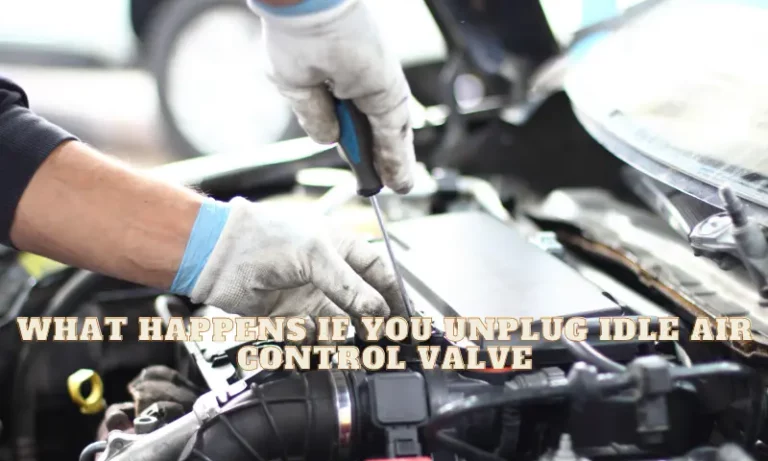When it comes to maintaining your car’s engine, understanding the role of the idle air control valve is essential. This little component helps regulate the idle speed of your engine, ensuring a smooth and consistent performance while you’re at a standstill. In this article, we’ll explore what happens if you unplug the idle air control valve and whether it’s safe to do so.
At times, you may experience fluctuations in idle speed or difficulty starting your car, which might prompt you to unplug the idle air control valve. While this action may seem like a quick fix, it’s essential to be aware of the potential consequences, and understand the importance of addressing the underlying issues to prevent more significant engine problems down the road.
Learning About Idle Air Control Valve
Idle Air Control Valve (IACV), also known as the IAC valve, is an essential component in your vehicle’s engine management system. Its primary function is to regulate the flow of air entering the engine when you are idling. This helps maintain a smooth and stable idle RPM even under various loads and driving conditions.
The throttle body is responsible for controlling the air intake to your engine. When you step on the gas pedal, the throttle body opens up, allowing more air to enter the engine. The Engine Control Unit (ECU) uses the information from various sensors to manage the proper functioning of the engine. It adjusts the air-to-fuel mixture, ignition timing, and other parameters to optimize efficiency and performance.
The IAC valve communicates with your Engine Control Unit (ECU) to fine-tune the amount of air being supplied to your engine when idling. This precise air control is crucial because the engine requires a continuous air supply, even when it is not under power. Without a properly functioning IAC valve, your engine would struggle to idle smoothly and might stall or operate inefficiently.
It is important to note that a failing IAC valve can cause several symptoms like fluctuating idle speed, rough idling, engine stalling, and the illumination of the check engine light on your dashboard. If you notice any of these symptoms, it is essential to get it checked and possibly replaced to prevent any further damage.
Signs of a Malfunctioning IAC Valve
Engine Stalling and Rough Idling
If you notice your engine stalling or experiencing rough idling, it may be an indication of a malfunctioning Idle Air Control (IAC) valve. A poor IAC valve can cause your engine to stall at idle or even while driving. Keep an eye out for these symptoms to ensure your IAC valve is functioning properly.
Check Engine Light
Another sign of a potential IAC valve issue is the appearance of the Check Engine Light on your dashboard. This light could indicate several issues, but whenever it shows up, you should have your vehicle checked to identify the specific problem.
Difficulty Starting the Engine
Your car’s IAC valve plays a crucial role in managing your engine’s idle speed. If this valve is malfunctioning, you may encounter difficulties while trying to start your engine. Be aware of this issue, so you can address it in time, avoiding more significant consequences.
Reduced Fuel Efficiency
Lastly, a faulty IAC valve may result in reduced fuel efficiency. If your IAC valve isn’t working correctly, it can lead to incorrect readings and adjustments to your engine’s air-fuel mixture, resulting in poor fuel consumption. Keep track of your vehicle’s fuel efficiency to help identify any potential problems with your IAC valve.
What Happens When You Unplug Idle Air Control Valve
When you unplug the Idle Air Control (IAC) valve in your vehicle, it could lead to various engine problems and compromises on overall safety. In this section, we’ll discuss the impacts on idle speed, potential damage to the engine, and safety concerns.
Effect on Idle Speed
Unplugging the IAC valve can cause the engine’s idle speed to fluctuate. Your car’s idle speed may become inconsistent, with the RPM (revolutions per minute) dropping lower or going higher than usual. This can lead to rough idling, which may be more noticeable during cold starts or when the engine is under certain conditions, like operating at high temperatures. Particularly, this could make driving uncomfortable and may eventually result in engine stalling.
Potential Damage to Engine
Disconnecting the IAC valve might temporarily alleviate certain issues, but it does not address the underlying problem with your vehicle’s engine management system. Ignoring the malfunctioning IAC valve can eventually lead to more serious engine problems. For example, decreased fuel efficiency and the possibility of irreversible damage to your engine may occur. It’s best to address the issue and have the IAC valve inspected, repaired, or replaced as necessary to avoid long-term consequences.
Safety Concerns
Lastly, it’s essential to consider the safety risks associated with unplugging your IAC valve. A malfunctioning IAC valve can cause your engine to stall while driving, posing a significant safety hazard, especially if it happens in situations where you suddenly lose power, like on a highway or during high-speed overtaking maneuvers. Being unable to maintain a stable idle speed could also lead to challenges in handling your vehicle, making it harder for you to navigate through traffic and potentially increasing the risk of accidents.
Cleaning and Replacing IAC Valve
When to Clean
If you notice that your car’s idle is rough or the RPM is fluctuating, it could be due to a malfunction in the Idle Air Control (IAC) valve. Over time, the IAC valve can become clogged with gunk, causing it to not function properly. In many cases, simply cleaning the IAC valve can solve these issues and restore its functionality.
To clean your IAC valve, it’s a good idea to first consult your car’s owner’s manual for specific instructions on how to access and clean the valve. Make sure to turn off your vehicle and let the engine cool before starting. Once you’ve located the valve, carefully remove it and use an appropriate cleaner, like throttle body cleaner or mass air flow sensor cleaner, to remove any buildup. After cleaning, reinstall the valve and start your car to see if the issue is resolved.
When to Replace
Sometimes, cleaning the IAC valve may not be enough, especially if the valve is faulty or damaged. In this case, you should consider replacing the IAC valve instead. Signs that it’s time for a replacement include persistent stalling, difficulty starting the engine, and decreased fuel efficiency, even after attempting to clean the valve.
When choosing a new valve, make sure to purchase one that is compatible with your car’s make and model. Follow the instructions provided in your car’s owner manual on how to replace the IAC valve, or consult a professional mechanic if you’re unsure or uncomfortable with the process. After the new IAC valve is installed, start your car to make sure the issues have been resolved and your car is running smoothly again.
Alternative Problems and Solutions
In some cases, the issues you may experience after unplugging the idle air control valve might not always be directly related to the IAC valve itself. It’s possible that there are other underlying problems contributing to the symptoms you’re encountering. This section will explore two possible causes: vacuum leaks and electrical connector issues.
Vacuum Leaks
A vacuum leak can cause symptoms similar to those of a faulty IAC valve. If you suspect a leak in your vehicle’s vacuum system, it’s essential for you to find and fix the problem. Some common signs of a vacuum leak include:
- Rough or fluctuating idle
- Poor engine performance
- Hesitation or stalling during acceleration
- Decreased fuel efficiency
To address a potential vacuum leak, try visually inspecting all vacuum hoses and connections for cracks, wear, and damage. Pay extra attention to areas where hoses are exposed to heat or abrasion. You can also spray carburetor cleaner around the areas where you suspect a leak while the engine is running. If the engine’s idle speed changes when you spray a specific area, it’s likely that there’s a leak nearby. After identifying the problematic connection or hose, replace or repair it as needed.
Electrical Connector Issues
Bad electrical connections can contribute to problems with your IAC valve. If you’ve ruled out a vacuum leak and the symptoms persist, it’s worth checking the electrical connector for the IAC valve. To address potential electrical issues:
- Inspect the wiring between the idle air control valve and the engine control module for damage, corrosion, or loose connections.
- Make sure the IAC valve’s electrical connector is secure, clean, and free of corrosion or debris.
- Conduct a continuity test on the wiring and connector to ensure there are no breaks or short circuits in the circuitry.
Careful troubleshooting of both vacuum leaks and electrical connector issues can help you resolve the problem and improve your vehicle’s performance. By taking a methodical approach and considering alternative causes, you can more accurately determine what’s affecting your engine and make the necessary repairs.
Conclusion
In a nutshell, unplugging your idle air control valve can temporarily solve issues like fluctuating idle speeds or hard starting. However, it’s essential to address the underlying problem and prevent more serious engine troubles.
Remember, always consult a professional mechanic for assistance and keep a friendly attitude towards maintaining your vehicle for a smooth and safe driving experience.



